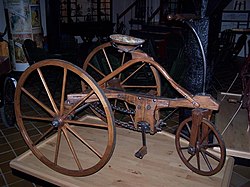Wheel

A wheel is a disc or circle-shaped mechanical device. Its main purpose is to allow things to roll; in other words, the wheel spins, and object on the wheels moves more easily along the ground. It is a simple machine.[1] The principle behind the wheel is that of mechanical advantage.[2]
Most land vehicles roll on wheels. Wheels are often used in pairs, connected by a rod of wood or metal known as an axle. The wheel and axle turn together. The part of the wheel that attaches to the axle is called the hub.
The wheel with an axle is the basis of many machines, not just vehicles. The potter's wheel, the lathe and the windlass are examples.[2] Many machines have wheels with teeth, known as gears.
History

Most experts believe that the ancient Mesopotamians invented the wheel about 4000 BC.[3][4]
People in Asia also discovered it on their own around 3500 BC. The Inca and Maya had wheels on children's toys around 1500 BC, but they did not use wheels for work. Africa south of the Sahara desert and Australia did not have the wheel until people there met people from Europe. Early wheels were solid disks; the spoked wheel was invented around 2000 BC. The earliest documentation of a vehicle with wheels is a painting dated between 3350–3500 BC.
Uses
Today, wheels are used in cars, carts, airplanes, wheelchairs, bicycles, trains, and skateboards, in addition to many more devices.
Wheel Media
Spoked wheel of reconstructed Celtic funerary wagon, 550 BCE, Hochdorf Chieftain's Grave, Germany
This Ljubljana Marshes Wheel with axle is the oldest wooden wheel yet discovered dating to Copper Age (c. 3130 BCE)
Solid wheels on a heavy temple car, contrasted with the lighter wire-spoked wheels of the black roadster bicycle in the foreground
Three spoked wheels on an antique tricycle
A wheel with car tire made by BMW company
References
- ↑ Prater, Edward L. 1994. Basic Machines, Naval Education and Training Professional Development and Technology Center, NAVEDTRA 14037
- ↑ 2.0 2.1 Bowser, Edward Albert, 1890, An elementary treatise on analytic mechanics: with numerous examples. (Originally from the University of Michigan) D. Van Nostrand Company, pp. 190
- ↑ True potter's wheels, which are freely-spinning and have a wheel-and-axle mechanism, were developed in Mesopotamia (Iraq) by 4200–4000 BC. D.T. Potts (2012). A Companion to the Archaeology of the Ancient Near East. p. 285.
- ↑ The oldest surviving example, which was found in Ur (modern day Iraq), dates to about 3100 BC.










